Table of Contents
Introduction to Best Pet Turtle for Beginners
Hey there, fellow turtle 🐢 enthusiasts! From my experience, finding the best pet turtle for beginners, especially, can feel a bit like navigating an exciting maze. There are so many turtle varieties out there that it’s easy to get lost. But fret not because that’s precisely why I’m here—to help you find your perfect, shelled buddy.
If you live in a flat with limited space, the thought of getting a large pet may seem daunting. That’s where our little friends, the rabbits 🐰, guinea pigs 🐹, hamsters 🐁, and in this case, the small turtles 🐢, come in.
Numerous pet turtle species naturally thrive in smaller spaces, making them great pets for those of us with cozy living situations. And the best part? You’ll be spoilt for choice, with some of the most popular species equally suited to beginners.
Now, before we dive into the world of small turtles, there’s one important thing you need to know: the 4-inch law in the US. 📏🇺🇸 This law prohibits the sale of turtles with shells less than four inches long. I know, I know, it sounds a bit quirky, right? But it’s all about safety since tiny turtles can pose a salmonella risk. So, while you might dream of an itty bitty turtle, starting with a slightly larger buddy is better (and legal!). No worries, though—plenty of awesome turtles out there fit the bill and are still perfect for small-space living. 💕
Key Takeaways
- 🐢 Choosing the Right Species: In my journey of turtle parenting, I’ve found some species particularly great for beginners. Painted turtles, box turtles, and red-eared turtles top this list! Each of these turtles has its own unique charm and care requirement. Just remember, no matter which species you choose, your new shelled buddy will need a healthy amount of love and care.
- 💡 Habitat Requirements: From my experience, ensuring a suitable habitat for your turtle is crucial. A large tank is a must for most turtle species, even the smaller ones. They love having room to swim around and explore. Additionally, a heat lamp and UVB light are non-negotiable for creating an environment similar to their natural habitat.
- 🍎 The Importance of a Varied Diet: Turtles thrive on varied diets. Aquatic plants, leafy vegetables, and small insects have been a hit with my turtles. Remember, a balanced, varied diet is vital to keeping your pet turtle healthy and happy.
- 🏞️ Sometimes, Bigger is Better: While small turtles are great for a flat living, if you have the option for a larger living space – go for it! I’ve noticed that my turtles have appreciated the extra room, especially the box turtles—they’re quite the little explorers!
Best Pet Turtle for Beginners
As a self-proclaimed turtle enthusiast 🐢, I’ve had the pleasure of sharing my space with several different species over the years, and let me tell you, it has been an utterly rewarding journey!
In the following sections, we will dive into the world of the best pet turtles for beginners, particularly focusing on some species that have proven to be excellent companions for beginners. We’ll cover the lively Red-Eared Slider, the vibrant Painted Turtle, and the adaptable Eastern Box Turtle.
So buckle up, fellow turtle lovers. We are about to embark on an exciting voyage into the captivating world of these charming shelled buddies! 🌊🐢💚
Red-Eared Slider: The Popular Starter Turtle
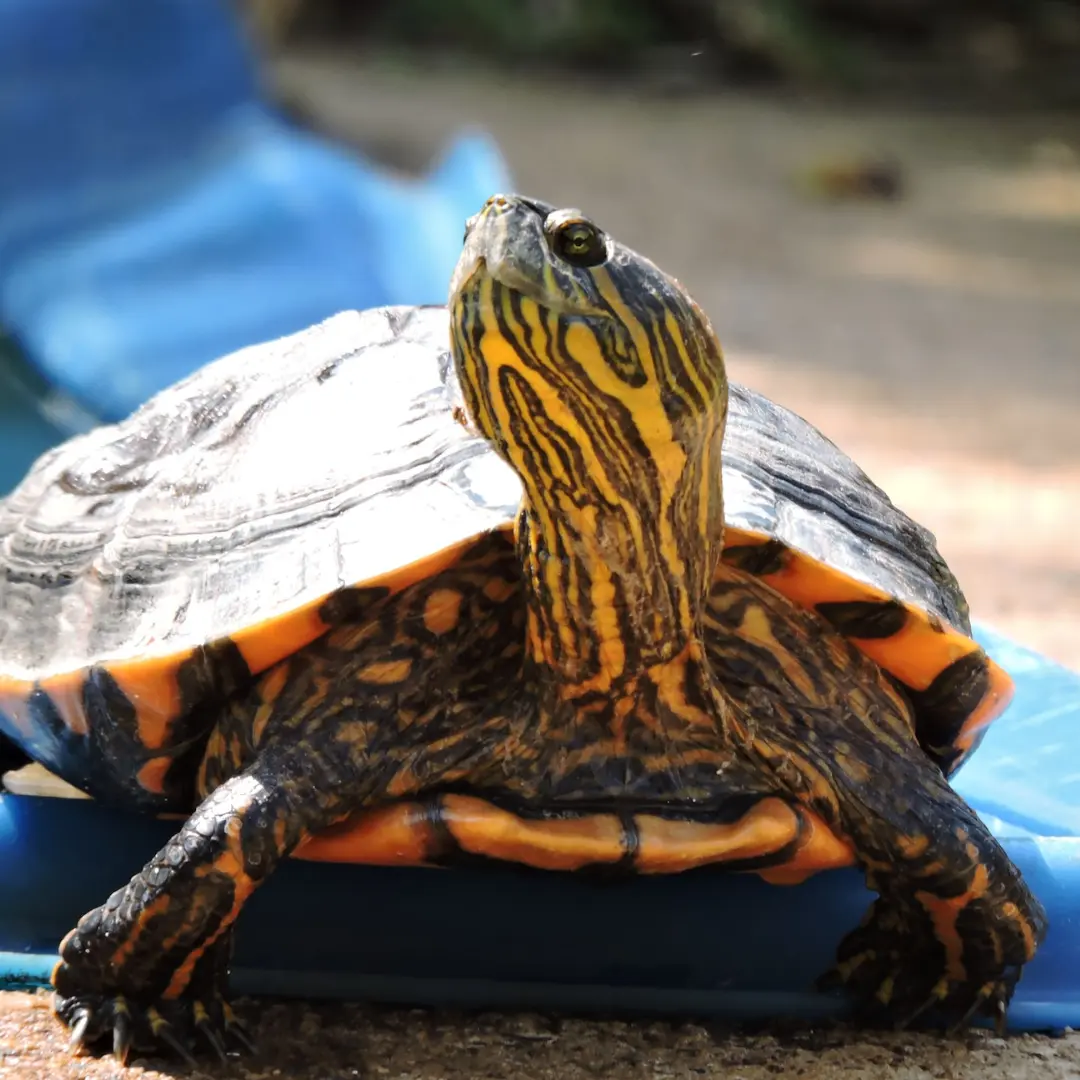
The Red-Eared Slider 🐢 is one of the most popular aquatic turtles among beginners. It’s a pet turtle species that loves to spend most of its time in the water, especially when they’re young. But don’t be surprised if you see them basking under a heat lamp now and then – they love a good sunbath, too ☀️😎!
Now, why is the Red-Eared Slider my number one option when looking for the best pet turtle for beginners, you ask? Well, the reasons are plenty:
- Survival Skills: Red-eared sliders are hardy creatures. They adapt quickly to different environments, making them a practical choice for new turtle parents.
- Availability: You can find it at most pet stores since they’re one of the most readily available turtle species.
- Size: While they can grow quite large (up to 12 inches), their small size 📏 in infancy makes them less intimidating for beginners.
- Eating Habits: They’re not fussy eaters. You can feed them commercial turtle pellets, bits of small fish, and even some aquatic plants 🥗.
- Lifespan: On average, a pet Red-Eared Slider can live between 20 to 30 years, and in some exceptional cases, they’ve been known to live up to 40 years! Adopting a Red-Eared Slider is a long-term commitment and requires consistent care throughout its life.
If you’re considering bringing a Red-Eared Slider into your home, remember that they require a large aquarium – the more space, the happier your turtle will be. These aquatic turtles live longer and healthier lives with plenty of room to swim and explore. 🐠🏠
So, if you’re ready to dive into the world of pet turtles, the Red-Eared Slider could be the perfect starter buddy for you!
Painted Turtle: The Colorful Companion
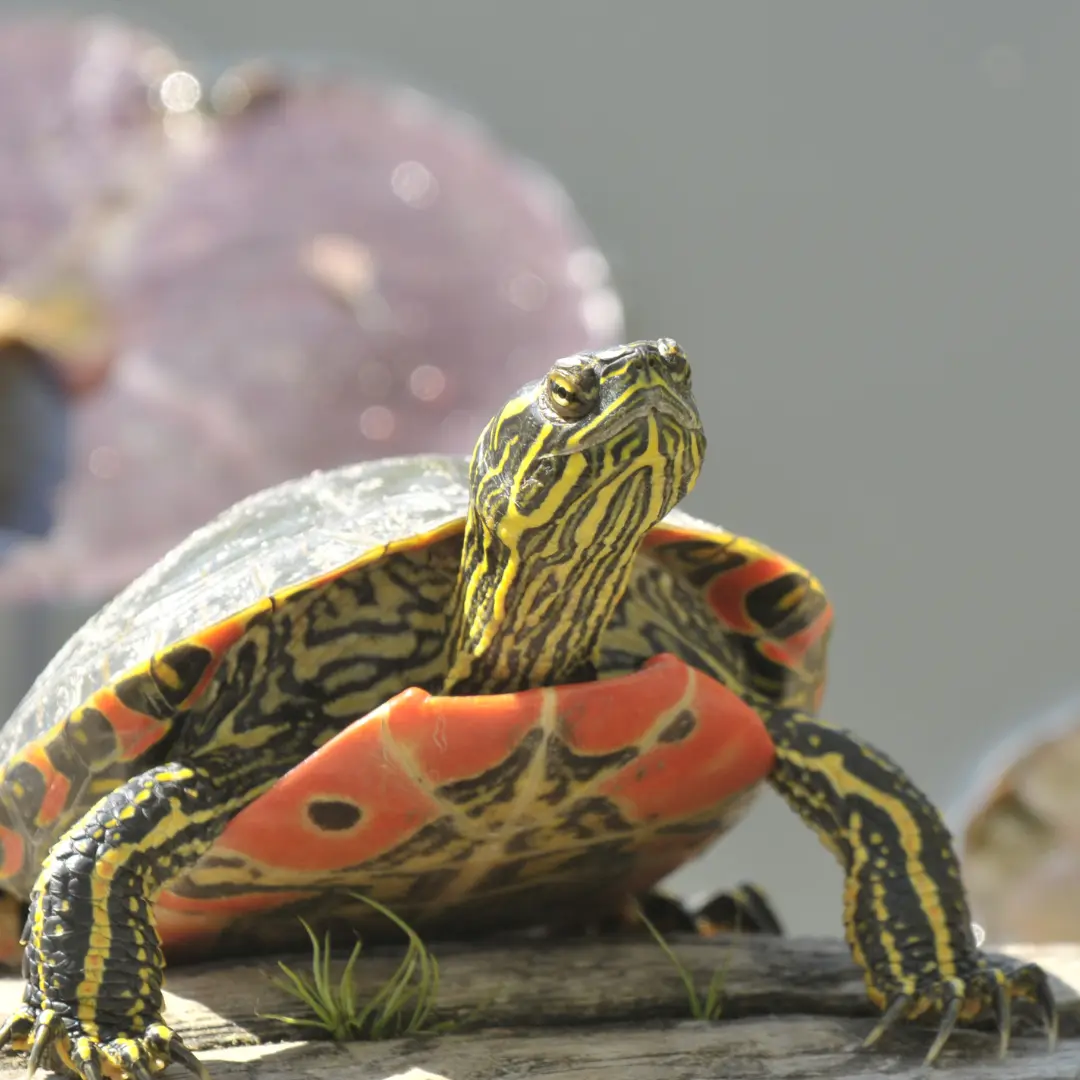
Meet the Painted Turtle, a favorite among beginner turtle enthusiasts and a marvel to behold. Also an aquatic species, these turtles love 💙 their swim time as much as any Red-Eared Slider! But what makes them truly stand out is their stunning array of colors! Their carapace (or shell, for the newbies out there 😉) is typically dark, almost black, adorned with red and yellow stripes that truly make them a sight to behold in any tank. 🎨🐢
Now, I bet you’re eager to know why these magnificent creatures are such a hit with beginners, so let’s dive right in. Here are some reasons:
- Size: Painted Turtles are smaller compared to many other turtles, typically measuring around 5 to 7 inches in length. Perfect for those of you still deciding whether to commit to a larger turtle species.
- Lifespan: These little dudes have a lifespan similar to Red-Eared Sliders, living on average between 20 to 30 years and even up to 50 years in some cases! 🎉
- Eating Habits: Just like their Red-Eared turtle, Painted Turtles aren’t picky eaters. A healthy mix of commercial turtle pellets and small fish should keep them happy. They also enjoy a nice leafy snack from time to time – hey, even turtles need their leafy greens! 🍏🐠
- Availability: You should be able to find a Painted Turtle at your local pet store without much hassle, as they’re pretty popular among turtle parents.
But remember, Painted Turtles, just like Chinese Pond Turtles and other species, require a UVB light in their tank for basking. So, if you’re ready to add a splash of color and life to your home, the Painted Turtle might be your perfect new friend! 🌈🏡
Eastern Box Turtle: A Terrestrial Option
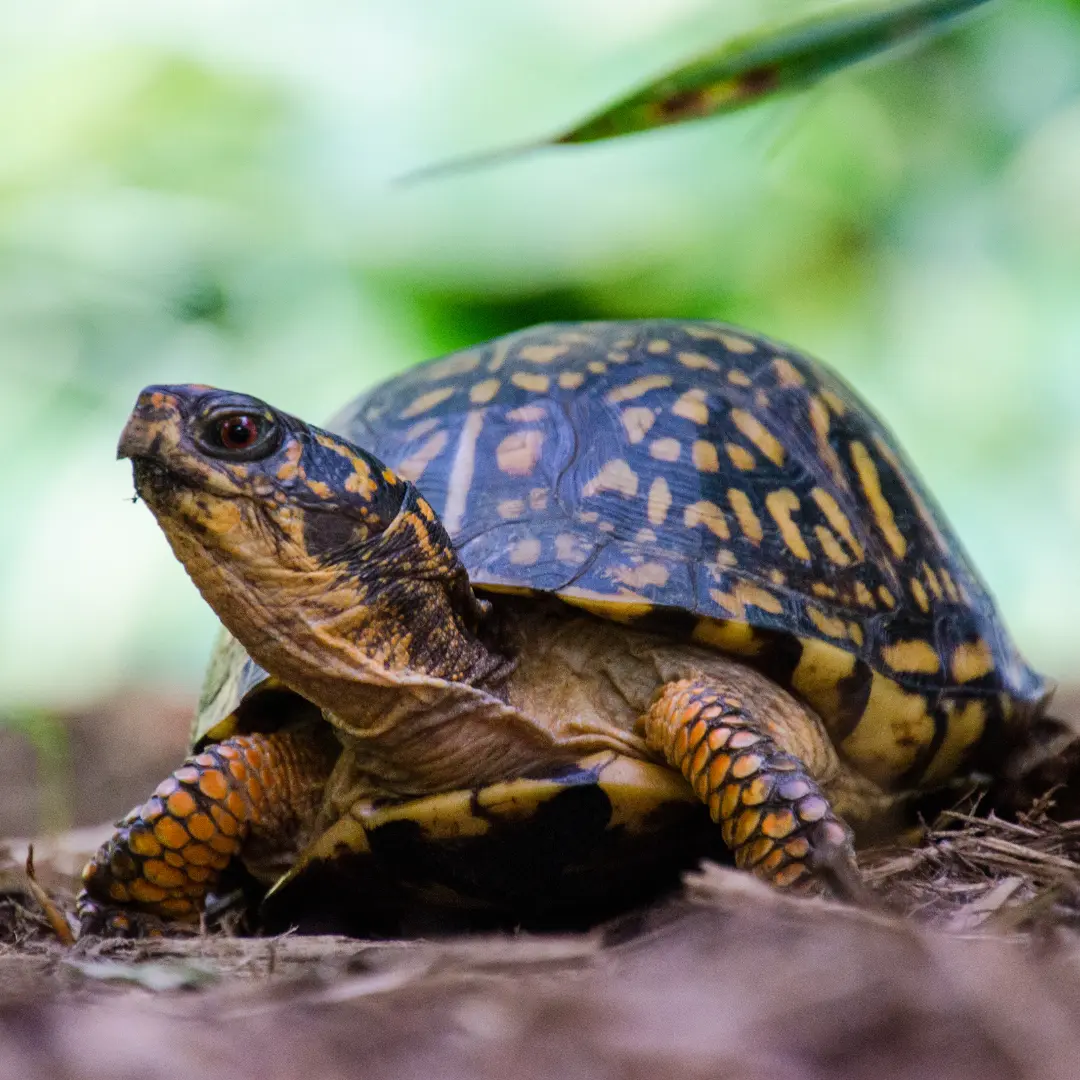
If you’re looking for a turtle that prefers the terra firma to deep waters, let me introduce you to the Eastern Box Turtle. 🐢🌳 Unlike their aquatic relatives, such as the Eastern Mud Turtle and Musk Turtles, Eastern Box Turtles are land turtles, making them a fantastic option for those of you who would rather skip the complex water filtration systems.
Here’s why this buddy is an excellent choice for beginners:
- Size: Eastern Box Turtles stay relatively small, even in adulthood. Their adult size typically ranges from 4.5 to 7 inches, making them much more manageable for new turtle parents.
- Lifespan: These patient pals can live up to an impressive 40 to 60 years, giving you plenty of time to bond and create lasting memories. 📅🐢
- Eating Habits: Eastern Box Turtles aren’t fussy eaters! They enjoy a broad diet that includes insects, fruits, berries, and vegetables. They are the epitome of not being picky – they’ll even munch on leaf litter from their home in their outdoor enclosure!
- Availability: While less widely available than Painted Turtles or Red-Eared Sliders, Eastern Box Turtles can often still be found at pet stores or through reputable breeders if you’re willing to look around a bit. 👀
Just like with other pet turtles, Eastern Box Turtles require a UVB light for basking, and their outdoor enclosure should include a moist area filled with leaf litter for them to hide and burrow. So, if you’re ready to bring a little piece of the forest into your home and don’t mind the occasional earthworm on the shopping list, the Eastern Box Turtle could be your new best friend! 🏡🌲🐢
Setting Up Your Turtle’s Habitat
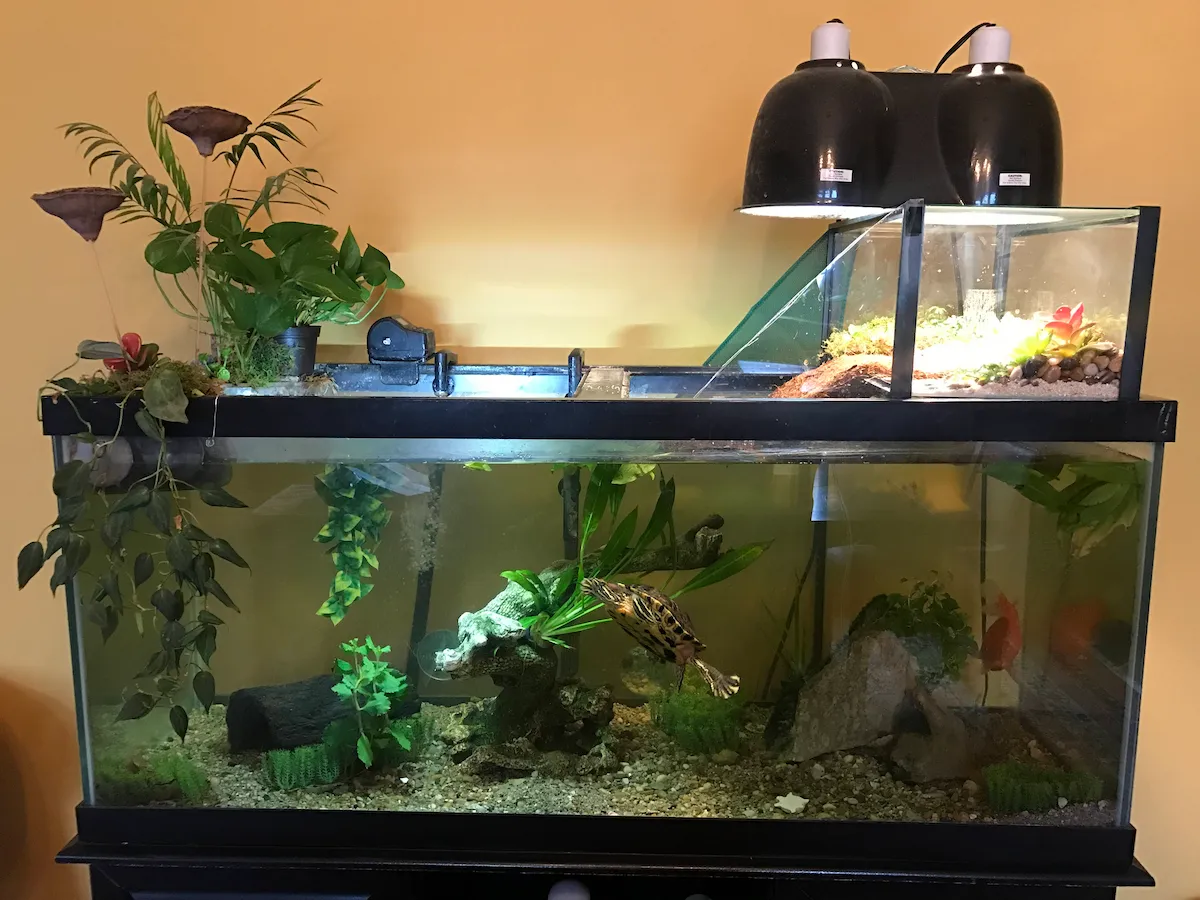
Size Matters 📏
As a turtle owner, one of the first things you need to consider when setting up your turtle’s habitat is the size of the enclosure. The rule of thumb is the larger, the better. 😊 Especially if you have a small turtle like the Mississippi map turtle, it might be tempting to start with a small enclosure, but remember, these tiny turtles grow, and they appreciate their space! A large enclosure lets you mimic their natural environment effectively, making your pet feel at home.
Heating and Lighting Essentials ☀️💡
Turtles, being ectothermic, depend on their environment to regulate their body temperature. So, heating and lighting are crucial aspects of any turtle habitat. You’ll want to create a basking platform with a heat lamp above it. This setup will allow your semi-aquatic turtles, like the western-painted turtle or the diamondback terrapin, to come out of the water to soak in the heat. Remember, they aren’t particularly strong swimmers and need a good spot to rest and warm up.
As for lighting, turtles need UVB light to help them produce vitamin D3, essential for their shell health. Make sure you change the UVB bulb every six months, as its ability to emit UVB light decreases over time, even if it is still shining 💡.
Aquatic Plants and Decor 🌱💧
Decorating your turtle’s aquatic habitat is about aesthetics and creating a comfortable and naturalistic home for your pet. Aquatic plants like Anacharis are great for oxygenating the water and providing hiding spots. Remember, turtles are curious creatures and love to explore 🔍!
Adding driftwood can also create a natural basking space and bring a touch of the wild to your indoor setup. However, always ensure your decor doesn’t have sharp edges that could hurt your pet turtle.
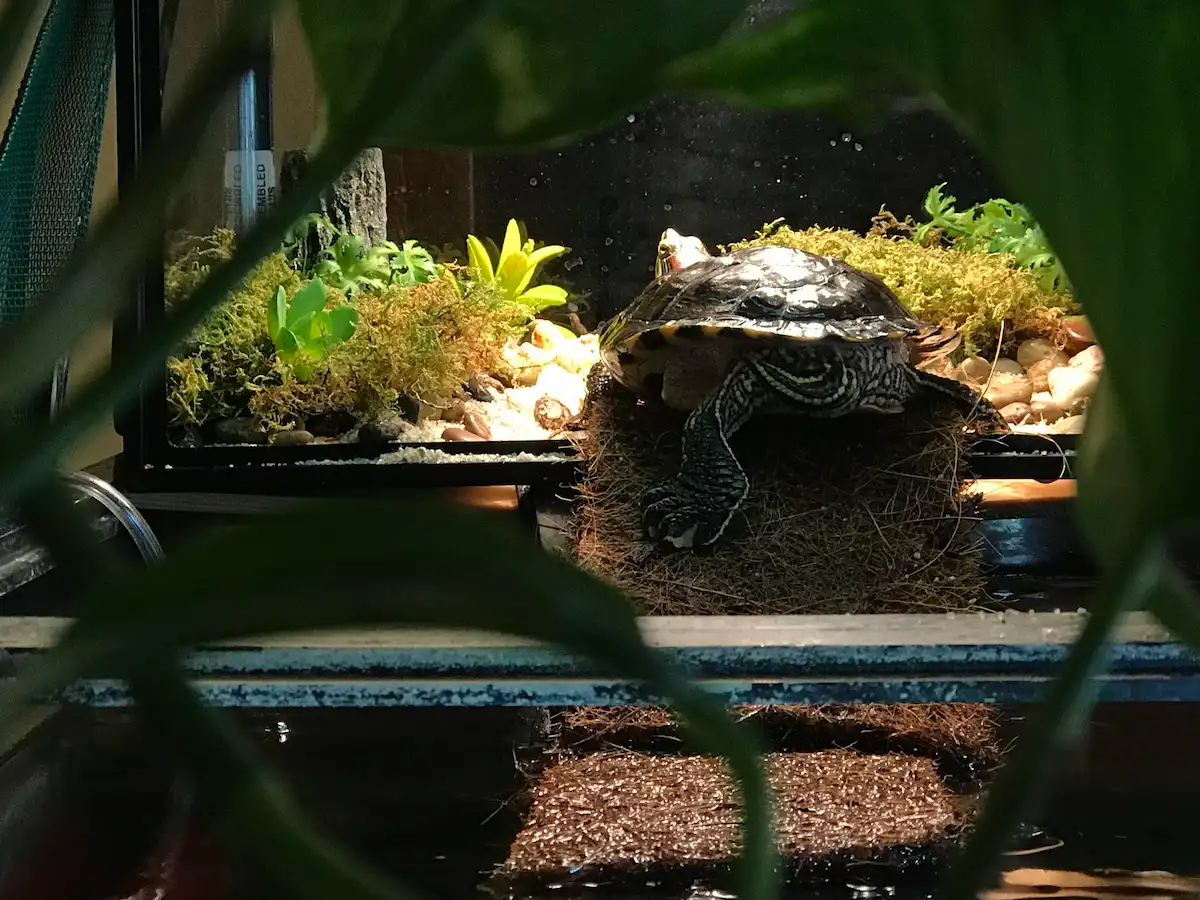
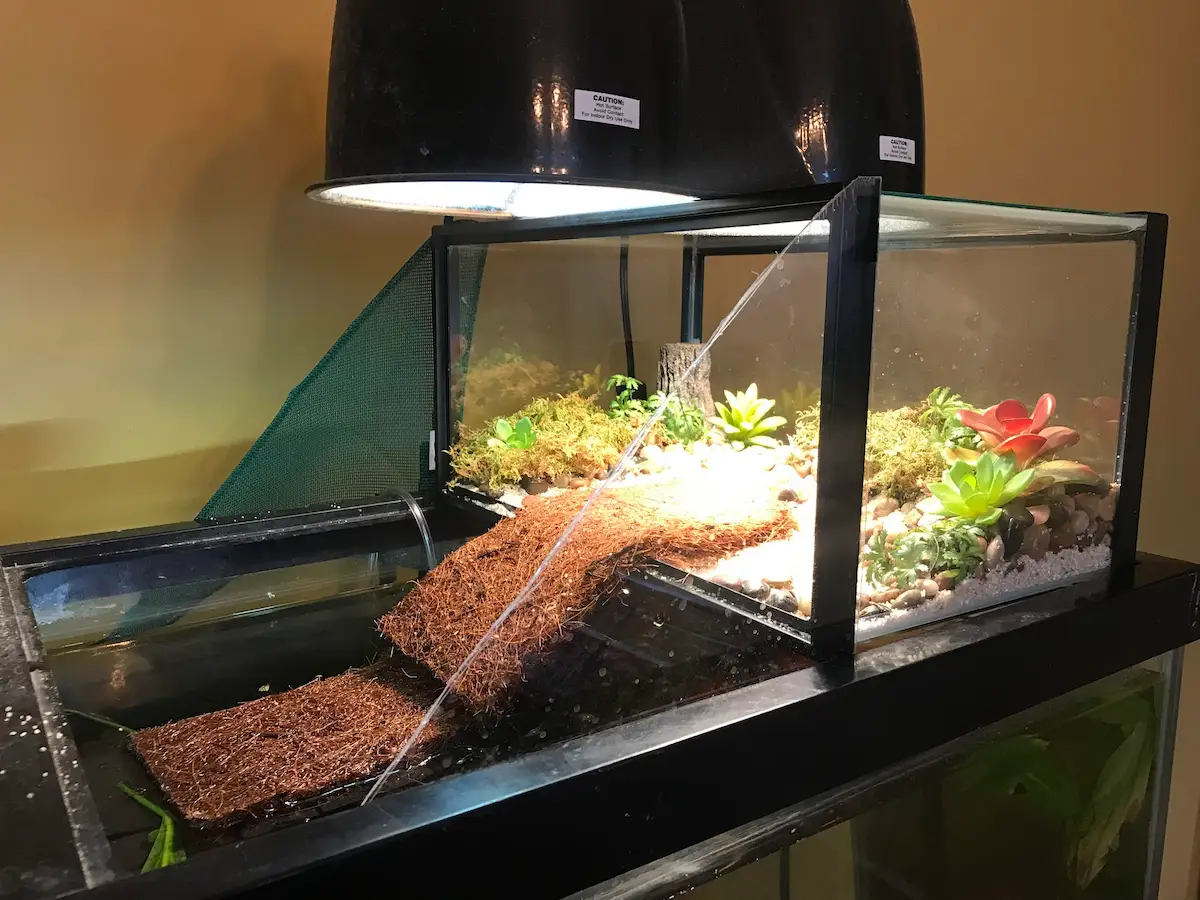
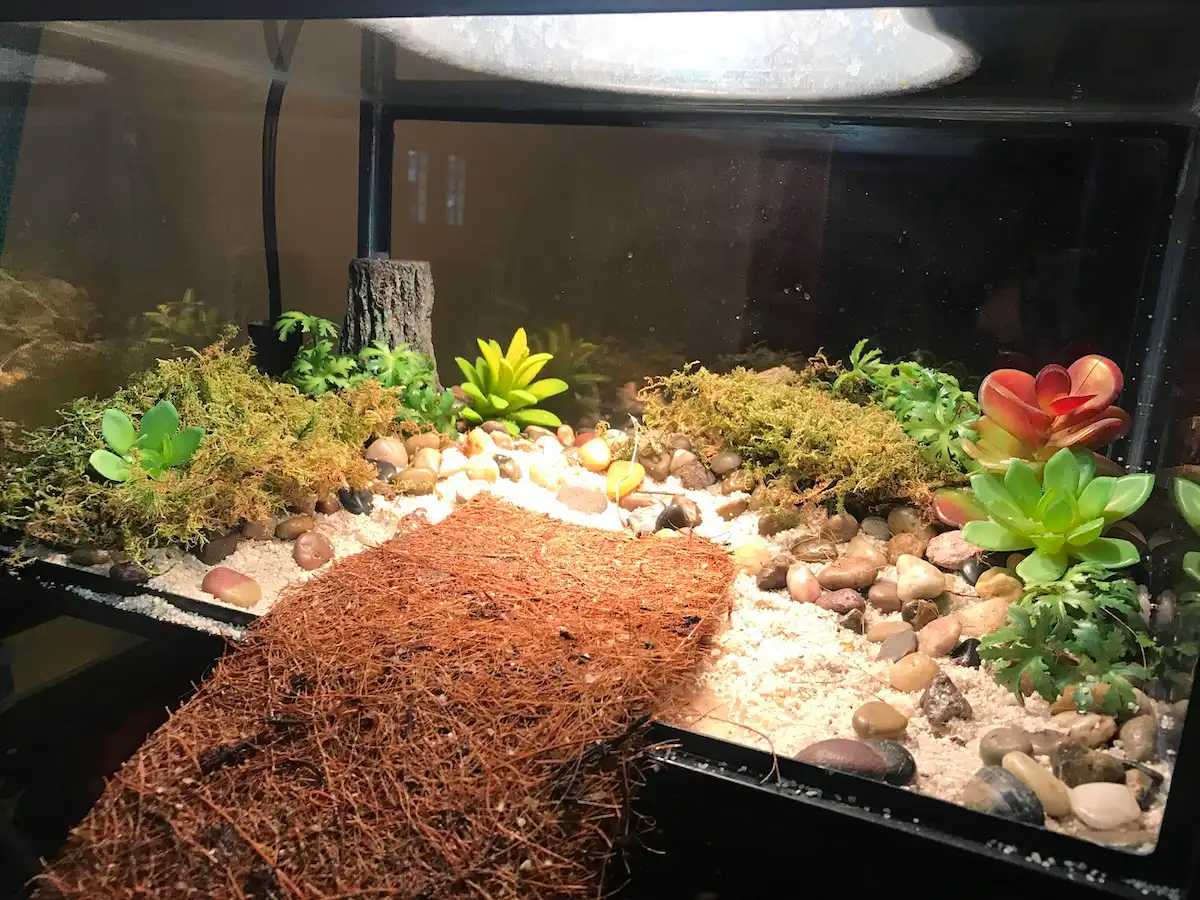
Setting up a turtle habitat isn’t just about ticking boxes on a checklist; it’s about creating an environment where your shelled friend can live and thrive happily. Keep the needs of your specific turtle species in mind, and you’ll surely create a habitat they’ll love! 💚🐢
Nutrition and Feeding: What to Feed Your Pet Turtle
When it comes to feeding a pet turtle, especially if it’s your first one, understanding their nutritional needs is essential. Different species have different dietary requirements, and recognizing this is the key to their health and longevity. Since this post is about the best pet turtle for beginners, let’s focus on the feeding habits of the mentioned species, but to be honest, it applies to most of the pet turtle species out there.

Commercial Turtle Pellets: A Staple, But Not the Full Deal 🐢🥣
As a turtle owner, you might find commercial turtle pellets extremely helpful, especially when you’re new to this and still figuring things out. They are easy to store and serve, packed with nutrients, and can be a good base for your pet’s diet.
I relied heavily on these pellets when I got my spotted turtle as a baby. They’re particularly beneficial for smaller turtles that need a protein-rich diet.
But remember, while these are great, they shouldn’t make up your turtle’s entire diet. Variety is key! 🗝️
Fresh Foods for a Varied Diet: The Colorful and Tasty Side of Life 🍓🥦
As we thrive on a balanced and varied diet, so do our shelled companions. Once your pet turtle reaches its adult size, it’s time to introduce various fresh foods.
My turtles absolutely love leafy greens, such as romaine lettuce and kale. You should also include a diverse selection of fruits and vegetables – strawberries, bell peppers, and sweet potatoes are some of their favorites. 🍓🥦
Just a heads up: turtles can be picky eaters initially, but keep trying, and they’ll soon start enjoying their fresh foods. Who knew turtles could have such foodie personalities?
Feeding Frequency and Portions: Not Too Little, Not Too Much ⏰🍽️
Feeding frequency and portions can be tricky to figure out.
For smaller turtles, feeding them once or twice a day works well. As they grow larger and reach adult size, you can cut back to feeding them every other day.
Now, how much to feed? Here’s a tip: the amount of food should be about the same size as your turtle’s head. This has always worked for me. Overfeeding can lead to obesity and poor shell health, so watch your pet turtle’s weight and adjust the diet as needed.
Health and Wellness: Keeping Your Turtle Thriving
Spotting Common Health Issues: Keeping an Eye on Our Shelled Friends
As a responsible pet turtle owner, recognizing common health issues is crucial. From my experience with different breeds – reeve’s turtle, red-eared terrapins, common musk turtles, among other aquatic turtles – they can all show similar signs of discomfort.
If your turtle becomes lethargic, refuses to eat, or develops discoloration or soft spots on its shell, it’s time to seek professional help. Remember, turtles can be masters of disguise regarding their health, so keep your eyes open! 🐢👀
Regular Vet Check-ups: Prevention is Better than Cure!
I can’t stress this enough – regular vet check-ups are a must for all pet turtle owners! These check-ups can help detect potential health issues early on, even before your turtle shows signs of discomfort.
My rule of thumb? Do a check-up every six months or so. You’ll thank yourself later! 🏥 🐢
Cleanliness and Hygiene: A Clean Turtle is a Happy Turtle!
Finally, let’s talk about cleanliness and hygiene. Keeping your turtle’s environment clean is crucial in preventing diseases. It might seem like a chore, but trust me, it’s worth it!
From my experience, I’ve found that cleaning the tank and switching out the water at least once a week works wonders for my turtles’ health and happiness. Plus, who wouldn’t want to live in a clean and hygienic home, right? So, grab that scrubbing brush, and let’s get cleaning! 🧽
Common Mistakes to Avoid as a New Pet Turtle Owner
Alright, let’s dive straight into it. One of the biggest mistakes I see new turtle owners make is underestimating the long-term commitment. 🐢💚 Turtles are not just cute little pets you can show off to your friends; they require a lifetime of dedication. Some turtle species can live more than 30 years, so always think long-term before bringing a turtle into your home.🏡
Next up, let’s chat about the tank water quality. It’s easy to overlook this, but maintaining the water quality in your turtle’s tank is vital for its health. 💧🐢 Poor water quality can lead to all sorts of infections and diseases. I highly recommend investing in a good water filter and regularly testing the water for harmful substances. It’s a bit of extra work, but keeping your turtle healthy and happy is worth it.
Lastly, let’s remember the need for socialization and stimulation. Turtles are solitary creatures by nature, but that doesn’t mean they don’t need any mental stimulation. 🧠🐢 You might occasionally introduce some toys or rearrange the tank setup to keep things interesting for your pet turtle. Trust me, they appreciate the change of scenery!
Remember, caring for a turtle isn’t as simple as it might seem initially. It’s a long-term commitment and requires consistent attention and care. But with the right mindset and dedication, you’ll find it a rewarding experience. 🐢💕
Choosing the Right Turtle for Your Lifestyle
Like humans, each turtle species has its unique personality, activity level, and care requirements. Before bringing a shelled friend into your home, assessing a few things is essential.
Firstly, consider the space and budget you have. Turtles, especially the larger species, require ample space to roam around and recreate their natural habitat. 🌿🐢 Consider whether your current living situation accommodates a large tank or pond. Also, setting up a proper habitat and ongoing maintenance (like feeding and vet care) can be quite costly. So, you want to ensure you’re financially ready for this commitment.
Next up, let’s talk about activity levels. A highly active turtle species may not be the best match if you’re a couch potato. 🤷 On the other hand, a turtle with a similar energy level can be a great companion if you’re all about movement and exploration.
Remember, choosing the right turtle for your lifestyle isn’t just about what you want; it’s also about what’s best for the turtle. Your little shelled friend will be with you for many years, so take the time to make the right choice. 🐢💚
Wrapping Up
When it comes to the best pet turtle for beginners, any of the above species is a good choice. They are relatively easy to care for, making any of them an excellent option for first-time turtle parents. They are beginner-friendly but still require a suitable habitat, proper nutrition, and regular care.
In my experience, welcoming a pet turtle into my home has been a journey filled with learning, bonding, and much joy. 🥰 It’s about more than just having a pet; it’s about sharing your life with a delightful creature with a personality all its own.
So, take the leap only after you’ve done your research and are fully prepared for the commitment. Turtles might be slow, but they swiftly make their way into your heart. It’s a ride worth taking. 🌈🐢

